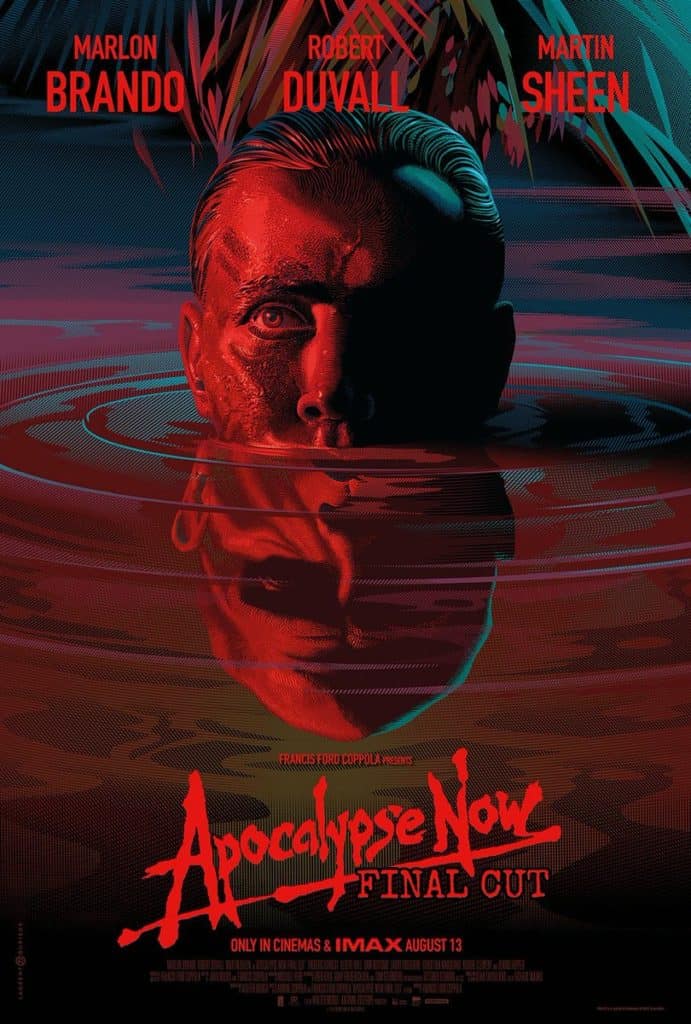If you’ve read previous posts you’ve heard me talk about the need to master the 3 Act Structure when writing your Screenplay.
That’s why I created Story Architecture which is my Act by Act breakdown of the 45 elements your Screenplay needs to fulfil the 3 Act Structure, be engaging, surprising, build coherently and express the complexity of your story and characters.
However, it isn’t a strict formula, you don’t have to include all of the elements, some scenes may have multiple elements in them, and they don’t have to appear in this order.
Recently I wrote a post with a breakdown of the film Misery to demonstrate how Act 1 of the 3 Act structure works for a major film.
The response to that post was incredible with people saying they found it really helpful.
So I thought I would do it again but this time for the legendary film Apocalypse Now. Below are the first 15 elements of Act 1 broken down.
Act 2 and 3 are available in my 1 Step-A-Day training program. For more information please visit my membership page.
Act 1 Story Architecture Elements 1-15
Summary
1. Introduce Protagonist
2. Create Empathy
3. Set Tone
4. Introduce Theme
5. Skills & Abilities
6. Introduce Antagonist
7. Inciting Incident
8. First Step
9. Avoidance
10. Introduce Supporting Characters
11. Subplot Scenes
12. First Set Back
13. Set Up Climax
14. Backstory
15. Act 1 Climax
Apocalypse Now - Final Cut
Screenplay by
John Milius & Francis Ford Coppola
Narration
Michael Herr
Based on novel
Heart Of Darkness
by
Joseph Conrad
As a teenager I read Heart Of Darkness for an English Literature class and fell in love with it immediately. When I heard Apocalypse Now was a loose adaptation of Heart Of Darkness I had to see it. Like the book, I fell in love with the film and Francis Ford Coppola’s audacious take on the Vietnam War. To this day the book and film both still rank in my favourites.
I have watched Apocalypse Now theatrical release countless times but only watched the Redux once. Whilst it was interesting to see the new footage, it was clear why Coppola cut many of those scenes, they were weak and overly long.
When I heard the Apocalypse Now Final Cut was getting an international theatrical release I was excited to see this version, which is halfway between the original release and the Redux.
The Final Cut captures the visually stunning cinematography by Vittorio Storraro, the extraordinary soundscape has been further enhanced and the brilliant performances still hold up. Most importantly the screenplay, a complex and fascinating character study, is still one of the most unique and engaging war stories ever written.
Logline
A U.S. Army officer serving in Vietnam is tasked with assassinating a renegade Special Forces Colonel who sees himself as a god.
1. Introduce Protagonist
Opening image of the protagonist and what their current world and situation is.
Apocalypse Now
Captain Willard, a young and handsome soldier is isolated in a hotel room in Saigon. He is traumatised and troubled, his voice over reveals he has returned to the war as he couldn’t adjust to civilian life. He grapples with inner demons and drinks himself into a chaotic spiritual state.
2. Create Empathy
To become emotionally invested in the story the audience needs to empathize with the protagonist.
Tricks to create empathy are: Misfortune, Power, They Are the Best, Humour, Other Characters Admire Them, Powerful.
Apocalypse Now
Misfortune
Willard has been psychologically scarred by what he has seen and done as a soldier. It has destroyed his marriage, he has lost part of himself and is in a struggle between the good and dark side of his soul – his heart of darkness.
Awareness
He has an observational quality and can put the insanity of the war happening around him into perspective.
“Charging a man with murder in this place was like handing out speeding tickets at the Indy 500”
He has a greater self-awareness compared to other characters who don’t have insight or don’t care how they behave, like the CIA agent or the reckless Kilgore.
He makes intelligent and entertaining observations about the crew on the River Patrol Boat (RPB)
PBR crew.
“They were rock and rollers with one foot in their graves”
“Chef was from New Orleans, he’s was wrapped too tight for Vietnam…probably wrapped too tight for New Orleans”
The Best
Of the five soldiers on the RPB he is the best and most experienced soldier.
He is a man of his word who can be trusted, when he’s asked about previous secret missions he replies
“I am unaware of any such activity or operation, nor would I be disposed to discuss such an operation, if it, did in fact, exist”
Mystery
There is a mystery surrounding his character, we want to know why he is in such a chaotic spiritual state and what he is grappling with.
3. Set Tone
If your screenplay is a Comedy – have some laughs, a Thriller – have a race against time or risky situation, an Action – have a chase or fight , a Horror – home some scares, a death or a haunting.
Apocalypse Now
Apocalypse now is a war film with philosophical undertones. The tone is set in a few key moments.
The war tone is set in the opening scene which depicts helicopters bombing the Vietnamese jungle.
There are two major battle scenes in Act 1 – When the RPB first meets up with the Air Calvary who have attacked a village and the famous air strike with the helicopters blasting Wagner through speakers.
Philosophically Willards voice over muses on the absurdities of the war and his own journey into the darkness of his heart.
4. Introduce Theme
Is the story about Justice, Survival, Love, The American Dream.
Is the theme a question to be explored – Can men and women be friends?
A moral – Crime doesn’t pay!
Apocalypse Now
Apocalypse Now is an existential crisis of the duality of the human heart.
“There’s a conflict in every human heart between the rational and the irrational, between good and evil. And good does not always triumph. Every man has got a breaking point.”
The story is a journey into Willards heart as he grapples with the idea of killing a fellow American soldier. It poses the question ‘If you venture to the darkest place of your soul can you return and redeem yourself’?
5. Skills & Abilities
Show some of the specific skills or abilities the protagonist has that they’ll need later in the story.
Apocalypse Now
In the voice over Willard asks himself “How many people had I already killed? There were those 6 I know for sure”
Willard is capable of killing people and he’s somewhat indifferent to it. However they were enemy combatants and the idea of killing a fellow American soldier is a moral dilemma for him.
Due to his rank and the voice over detailing his training we know that he is a skilled and accomplished soldier who can be trusted with clandestine missions.
6. Introduce Antagonist
Opening image of them and what they are doing.
Colonel Kurtz doesn’t appear until the 3rd Act but we initially hear his voice on a tape recording and see photos of him. As Act 1 progresses Willard studies a dossier on Kurtz and we learn his back story, philosophical world view and what drove him to form his rogue army in the Cambodian jungle.
7. Inciting Incident
The event that throws the protagonists world out of balance which sets up the goal of the story they strive to achieve. From the inciting incident emerges the Dramatic Question which must be answered by the end of the story.
Apocalypse Now
Willard is summoned to meet with army officials and a CIA agent. He’s informed Colonel Kurtz has defected and waging a proxy war in Cambodia with a militia army that worship him like a god. Willard is given the mission to go up the river, find Kurtz and kill him…or to quote the great use of subtext.
“Exterminate the Colonels command, with extreme prejudice”
Apocalypse Now’s Dramatic Question is
Will Willard find Kurtz and bring himself to kill him?
8. First Step
If the protagonist chooses, is forced to engage or react to the inciting incident, what is the First Step they take to achieve their goal or solve their problem?
Apocalypse Now
Willard takes the mission immediately
“I wanted a mission and for my sins I got one.”
His first step is to join the crew on the RPB and head to the Nung river where he can pick up Kurtz’s trail.
9. Avoidance
If the protagonist doesn’t react or refuse to engage how and why do they do this?
Apocalypse Now
There is no avoidance as Willard commits to the goal straight away.
10. Introduce Supporting Characters
Introduce some of the supporting characters, though not all have to be introduced in Act 1.
Apocalypse Now
The crew on the RPB are the supporting characters. They comprise of
Chief – The boats captain,
Chef – The tightly wound chef from New Orleans
Lance Johnson – A famous surfer
Mr Clean – A 17 year old kid.
Apocalypse Now structurally is a quasi road movie so it has various support characters along the way. In this type of story the protagonist passes through locations where they encounter characters and conflicts. When the protagonist moves to the next location those characters typically leave the story.
11. Subplot Scenes
Commence a subplot.
Apocalypse Now
Apocalypse Now doesn’t have subplots but rather sequences with events and conflicts at various locations along the river.
12. First Set Back
What is the first set back the protagonist encounters in striving to achieve their goal?
Apocalypse Now
Lieutenant Colonel Kilgore is a supporting character who is also an antagonist to Willard. Kilgore is a brash cowboy like leader who marshals the Air Calvary and loves war which is expressed perfectly with the most famous line from the film
“I love the smell of napalm in the morning”.
Kilgore is initially reluctant to help Willard as he didn’t receive the orders. However he’s an avid surfer so when he discovers that Lance Johnson is part of the RPB crew he agrees to help.
13. Set Up Climax
Show any specific elements for the climax to work.
Apocalypse Now
In the opening sequence the visuals dissolve between helicopters attacking the jungle, Willard drinking in the Saigon hotel and Kurtz’s compound. We later learn these are flash forwards and foreshadow the 3rd Act Climax.
14. Backstory
What is part of the protagonist’s back story?
Apocalypse Now
In the opening scene we learn when Willard was back in America after his first tour he couldn’t adapt to life and all he wanted was to be back in the jungle. This had a negative impact on his relationships and he
“didn’t speak to his wife until she said yes to a divorce”.
He is now a man defined as ‘soldier’ with nothing left in his life apart from combat.
15. Act 1 Climax
A point of no return, committing to the goal, a major set back, a major development, a revelation, a transition to new world – is it positive or negative event?
Apocalypse Now
The Act 1 Climax is the famous helicopter airstrike where Kilgore’s Air Calvary attack the village to the sounds of Wagner’s Ride Of The Valkyries. It’s an epic battle scene with stunning visuals, comic absurdity and mesmerising war choreography. The sequence juxtaposes explosions, machine gunning and napalm strikes with soldiers surfing.
Interestingly Willard is somewhat passive as he requires Kilgore to achieve this part of his goal. The scene climaxes with the Air Calvary defeating the Vietnamese and dropping the RPB into the Nung river. Kilgore begs for Lance Johnson to stay and surf but Willard insists they must leave and for a laugh they steal Kilgores surfboard then flee. They now head up the river towards Kurtz, the journey proper has begun.
The Act 1 Climax is a positive development.
[FREE] Download this as a pdf





